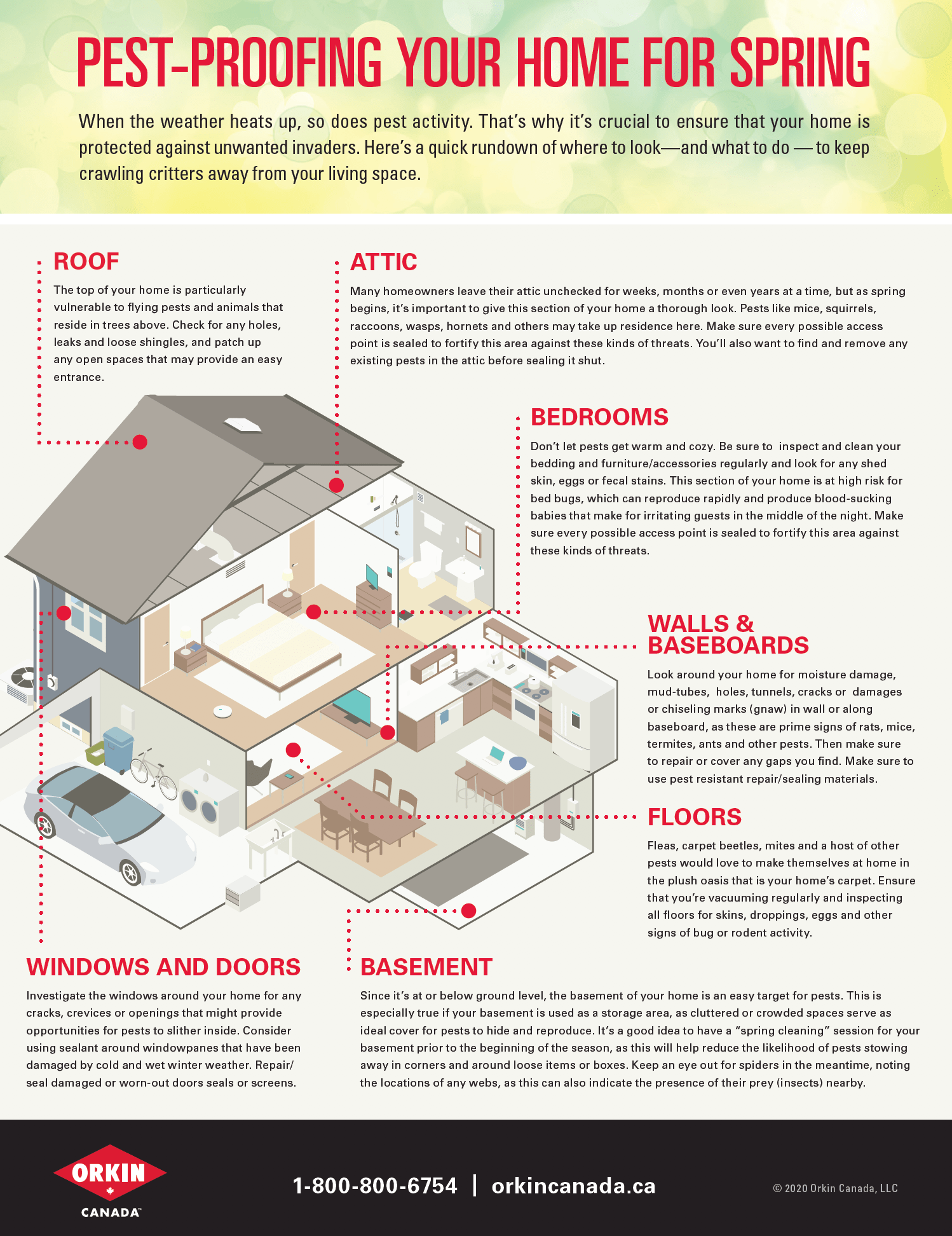When the weather heats up, so does pest activity. That’s why it’s crucial to ensure that your home is protected against unwanted invaders. Here’s a quick rundown of where to look—and what to do — to keep crawling critters away from your living space.
Roof
The top of your home is particularly vulnerable to flying pests and animals that reside in trees above. Check for any holes, leaks and loose shingles, and patch up any open spaces that may provide an easy entrance.
Attic
Many homeowners leave their attic unchecked for weeks, months or even years at a time, but as spring begins, it’s important to give this section of your home a thorough look. Pests like mice, squirrels, raccoons, wasps, hornets and others may take up residence here. Make sure every possible access point is sealed to fortify this area against these kinds of threats. You’ll also want to find and remove any existing pests in the attic before sealing it shut.
Bedrooms
Don’t let pests get warm and cozy. Be sure to inspect and clean your bedding and furniture/accessories regularly and look for any shed skin, eggs or fecal stains. This section of your home is at high risk for bed bugs, which can reproduce rapidly and produce blood-sucking babies that make for irritating guests in the middle of the night. Make sure every possible access point is sealed to fortify this area against these kinds of threats.
Walls & Baseboards
Look around your home for moisture damage, mud-tubes, holes, tunnels, cracks or damages or chiseling marks (gnaw) in wall or along baseboard, as these are prime signs of rats, mice, termites, ants and other pests. Then make sure to repair or cover any gaps you find. Make sure to use pest resistant repair/sealing materials.
Floors
Fleas, carpet beetles, mites and a host of other pests would love to make themselves at home in the plush oasis that is your home’s carpet. Ensure that you’re vacuuming regularly and inspecting all floors for skins, droppings, eggs and other signs of bug or rodent activity.
Basement
Since it’s at or below ground level, the basement of your home is an easy target for pests. This is especially true if your basement is used as a storage area, as cluttered or crowded spaces serve as ideal cover for pests to hide and reproduce. It’s a good idea to have a “spring cleaning” session for your basement prior to the beginning of the season, as this will help reduce the likelihood of pests stowing away in corners and around loose items or boxes. Keep an eye out for spiders in the meantime, noting the locations of any webs, as this can also indicate the presence of their prey (insects) nearby.
Windows and Doors
Investigate the windows around your home for any cracks, crevices or openings that might provide opportunities for pests to slither inside. Consider using sealant around windowpanes that have been damaged by cold and wet winter weather. Repair/ seal damaged or worn-out doors seals or screens.
Need a quick reference guide for all of this? You can also download our expert tip sheet here. 

You may also like
Canada's Top 25 Bed Bug Cities Of 2023
Bed bugs are extremely efficient hitch hikers. They can move easily across a room and climb onto luggage or anything left on a bed in just one night. Learn which cities have made Canada’s top 25 bed buggiest cities.
British Columbia's Top 20 'Rattiest' Cities 2023
As winter approaches, pest control leader Orkin Canada reminds homeowners and business owners to take precautions to help keep rodents out. Cities are ranked by the number of rodent (rat & mice) treatments the company performed from August 1, 2021 through July 31, 2022.
Ontario's Top 25 "Rattiest" Cities 2023
Pest control leader Orkin Canada reminds home owners and business owners to take precautions to help keep rodents out. Cities are ranked by the number of rodent (rat & mice) treatments the company performed from August 1, 2022 through July 31, 2023. This ranking includes both residential and commercial treatments.
Eastern Canada's Top 15 'Rattiest' Cities 2023
As winter approaches, pest control leader Orkin Canada reminds homeowners and business owners to take precautions to help keep rodents out. Cities are ranked by the number of rodent (rat & mice) treatments the company performed from August 1, 2021 through July 31, 2022.
Remove pests from your home, and stop them from coming back
We work hard to listen, understand and assess your unique situation. Request a free, no-obligation estimate today for a customized pest program that fits your needs.
Request a Free Home EstimateRequest a Free Business Consultation


